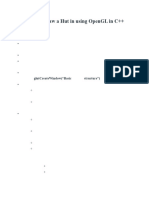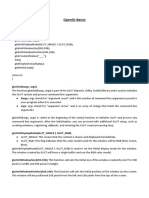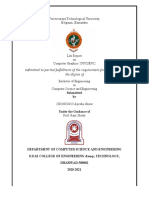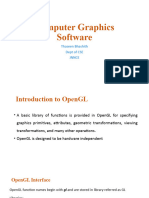Simple Opengl Program and Its Structure
Uploaded by
Ashwini RajuSimple Opengl Program and Its Structure
Uploaded by
Ashwini RajuComputer
Graphics with
OpenGL
Assignment
Submitted By:
Ashwini R.
1225911
V MCA
Question: Write Open GL program in C++ to draw two intersecting line segments.
Answer:
#include<iostream.h>
# include<GL/glut.h>
void init (void)
{
glClearColor(0,0,0,0);
glMatrixMode(GL_PROJECTION);
gluOrtho2D(0.0,200.0,0.0,155.0);
}
void LineSegment(void)
{
glClear(GL_COLOR_BUFFER_BIT);
glColor3f(1,0.0,1.0);
glBegin (GL_LINES);
glVertex2i(50,180);
glVertex2i(115,10);
glVertex2i(150,200);
glVertex2i(45,100);
glEnd();
glFlush();
}
int main(int argc,char** argv)
{
glutInit(&argc,argv);
glutInitDisplayMode(GLUT_RGB);
glutInitWindowPosition(50,100);
glutCreateWindow("CIA Program");
init();
glutDisplayFunc(LineSegment);
glutMainLoop();
return 0;
}
Output:
Question: Explain the structure of an Open GL program with help of an example.
Answer:
Generally OpenGL programs have a similar structure that has the following functions
main():
Specifies where the program execution should start.
init():
Sets the state variables
Species the callback functions
Opens the windows with the required properties
Sets attributes
callbacks
User defined function such as function for display, input and window functions.
Sample Outline Structure :
int main( int argc, char *argv[] )
{ // initialize the toolkit, set display mode (RGB / Single etc ..) and create window
glutInit( &argc, argv );
glutInitDisplayMode( GLUT_SINGLE | GLUT_RGB );
glutInitWindowSize( 640, 480 );
glutInitWindowPosition( 100, 150 );
glutCreateWindow( Sample Program );
// Register the callback functions
// Do the necessary initialisation
// wait in glutMainLoop for events
}
Sample Program:
#include<iostream.h>
#include <GL/glut.h>
void display()
{
glClear(GL_COLOR_BUFFER_BIT);
glBegin(GL_POLYGON);
glVertex2f(-0.5, -0.5);
glVertex2f(-0.5, 0.5);
glVertex2f(0.5, 0.5);
glVertex2f(0.5, -0.5);
glEnd();
glFlush();
}
int main(int argc, char** argv)
{
glutInit(&argc,argv);
glutCreateWindow("simple");
glutDisplayFunc(display);
glutMainLoop();
}
Output:
You might also like
- An Introduction On OpenGL With 2D Graphics - OpenGL Tutorial100% (1)An Introduction On OpenGL With 2D Graphics - OpenGL Tutorial39 pages
- CG Lab Programs Using Opengl: #Include VoidNo ratings yetCG Lab Programs Using Opengl: #Include Void32 pages
- Getting Started With Opengl: Woo, Neider Et Al., Chapter 1No ratings yetGetting Started With Opengl: Woo, Neider Et Al., Chapter 111 pages
- Program to Draw a Hut in Using OpenGL in CNo ratings yetProgram to Draw a Hut in Using OpenGL in C6 pages
- Set Primitive Color As Glcolor3F (R, G, B)No ratings yetSet Primitive Color As Glcolor3F (R, G, B)26 pages
- Configuring Eclipse and Freeglut On Windows For OpenglNo ratings yetConfiguring Eclipse and Freeglut On Windows For Opengl5 pages
- Visveswaraiah Technological University: Belgaum, Karnataka - 590 014No ratings yetVisveswaraiah Technological University: Belgaum, Karnataka - 590 01416 pages
- Mimansa Pathania, CG Lab File, 500091628No ratings yetMimansa Pathania, CG Lab File, 50009162826 pages
- Workshop Grafika Komputer - Primitive DrawingNo ratings yetWorkshop Grafika Komputer - Primitive Drawing24 pages
- CG Module 1.4 - Basics of 2D and 3D ObjectsNo ratings yetCG Module 1.4 - Basics of 2D and 3D Objects12 pages
- "Stdafx.h" "Glut.h": #Include #Include Void VoidNo ratings yet"Stdafx.h" "Glut.h": #Include #Include Void Void1 page
- Programming With Visual Studio MFC and OpenglNo ratings yetProgramming With Visual Studio MFC and Opengl25 pages
- Computer Graphics Using Opengl, 3 Edition F. S. Hill, Jr. and S. KelleyNo ratings yetComputer Graphics Using Opengl, 3 Edition F. S. Hill, Jr. and S. Kelley60 pages
- Opengl Installation: Open Graphics LibraryNo ratings yetOpengl Installation: Open Graphics Library3 pages
- Computer Graphics Through Opengl: From Theory To Experiments Experiments Chapter 2No ratings yetComputer Graphics Through Opengl: From Theory To Experiments Experiments Chapter 226 pages
- An Introduction On OpenGL With 2D Graphics - OpenGL TutorialAn Introduction On OpenGL With 2D Graphics - OpenGL Tutorial
- Getting Started With Opengl: Woo, Neider Et Al., Chapter 1Getting Started With Opengl: Woo, Neider Et Al., Chapter 1
- Configuring Eclipse and Freeglut On Windows For OpenglConfiguring Eclipse and Freeglut On Windows For Opengl
- Visveswaraiah Technological University: Belgaum, Karnataka - 590 014Visveswaraiah Technological University: Belgaum, Karnataka - 590 014
- Computer Graphics Using Opengl, 3 Edition F. S. Hill, Jr. and S. KelleyComputer Graphics Using Opengl, 3 Edition F. S. Hill, Jr. and S. Kelley
- Computer Graphics Through Opengl: From Theory To Experiments Experiments Chapter 2Computer Graphics Through Opengl: From Theory To Experiments Experiments Chapter 2
- Computer Engineering Laboratory Solution PrimerFrom EverandComputer Engineering Laboratory Solution Primer



























































